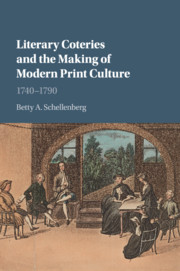Book contents
- Literary Coteries and the Making of Modern Print Culture
- Literary Coteries and the Making of Modern Print Culture
- Copyright page
- Contents
- Figures
- Tables
- Acknowledgments
- Abbreviations
- Introduction The literary coterie in the eighteenth-century media landscape
- Chapter 1 Wrest Park and North End
- Chapter 2 Formation, fame, and patronage
- Chapter 3 Identity and influence from coterie to print
- Chapter 4 Memorializing a coterie life in print
- Chapter 5 “This new species of mischief”
- Chapter 6 Transmediations
- Chapter 7 Literary sociability in the eighteenth-century personal miscellany
- Conclusion
- Notes
- Bibliography
- Index
- References
Bibliography
Published online by Cambridge University Press: 01 June 2016
- Literary Coteries and the Making of Modern Print Culture
- Literary Coteries and the Making of Modern Print Culture
- Copyright page
- Contents
- Figures
- Tables
- Acknowledgments
- Abbreviations
- Introduction The literary coterie in the eighteenth-century media landscape
- Chapter 1 Wrest Park and North End
- Chapter 2 Formation, fame, and patronage
- Chapter 3 Identity and influence from coterie to print
- Chapter 4 Memorializing a coterie life in print
- Chapter 5 “This new species of mischief”
- Chapter 6 Transmediations
- Chapter 7 Literary sociability in the eighteenth-century personal miscellany
- Conclusion
- Notes
- Bibliography
- Index
- References
- Type
- Chapter
- Information
- Literary Coteries and the Making of Modern Print Culture1740–1790, pp. 290 - 301Publisher: Cambridge University PressPrint publication year: 2016
- Creative Commons
- This content is Open Access and distributed under the terms of the Creative Commons Attribution licence CC-BY-NC-ND 4.0 https://creativecommons.org/cclicenses/



